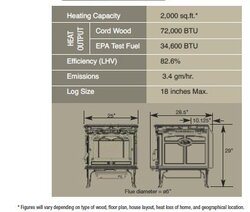http://www.chimneysweeponline.com/hobtucmp.htm
http://www.woodheat.org/planning/buyright.htm
EPA test method 28:
7.1 Test Fuel. The test fuel shall conform to the
following requirements:
7.1.1 Fuel Species. Untreated, air-dried, Douglas
fir lumber. Kiln-dried lumber is not permitted. The lumber
shall be certified C grade (standard) or better Douglas fir
by a lumber grader at the mill of origin as specified in the
West Coast Lumber Inspection Bureau Standard No. 16
(incorporated by reference - see §60.17).
7.1.2 Fuel Moisture. The test fuel shall have a
moisture content range between 16 to 20 percent on a wet
basis (19 to 25 percent dry basis). Addition of moisture to
previously dried wood is not allowed. It is recommended
that the test fuel be stored in a temperature and
humidity-controlled room.
7.1.3 Fuel Temperature. The test fuel shall be at
the test facility temperature of 18 to 32 EC (65 to 90 EF).
1409
7.1.4 Fuel Dimensions. The dimensions of each test
fuel piece shall conform to the nominal measurements of 2 ×
4 and 4 × 4 lumber. Each piece of test fuel (not including
spacers) shall be of equal length, except as necessary to
meet requirements in Section 8.8, and shall closely
approximate 5/6 the dimensions of the length of the usable
firebox. The fuel piece dimensions shall be determined in
relation to the appliance's firebox volume according to
guidelines listed below:
7.1.4.1 If the usable firebox volume is less than or
equal to 0.043 m3 (1.5 ft3), use 2 × 4 lumber.
7.1.4.2 If the usable firebox volume is greater than
0.043 m3 (1.5 ft3) and less than or equal to 0.085 m3 (3.0
ft3), use 2 × 4 and 4 × 4 lumber. About half the weight of
the test fuel charge shall be 2 × 4 lumber, and the
remainder shall be 4 × 4 lumber.
7.1.4.3 If the usable firebox volume is greater than
0.085 m3 (3.0 ft3), use 4 × 4 lumber.
7.2 Test Fuel Spacers. Air-dried, Douglas fir lumber
meeting the requirements outlined in Sections 7.1.1 through
7.1.3. The spacers shall be 130 × 40 × 20 mm (5 × 1.5 ×
0.75 in.).
http://www.caslab.com/EPA-Method-28/


